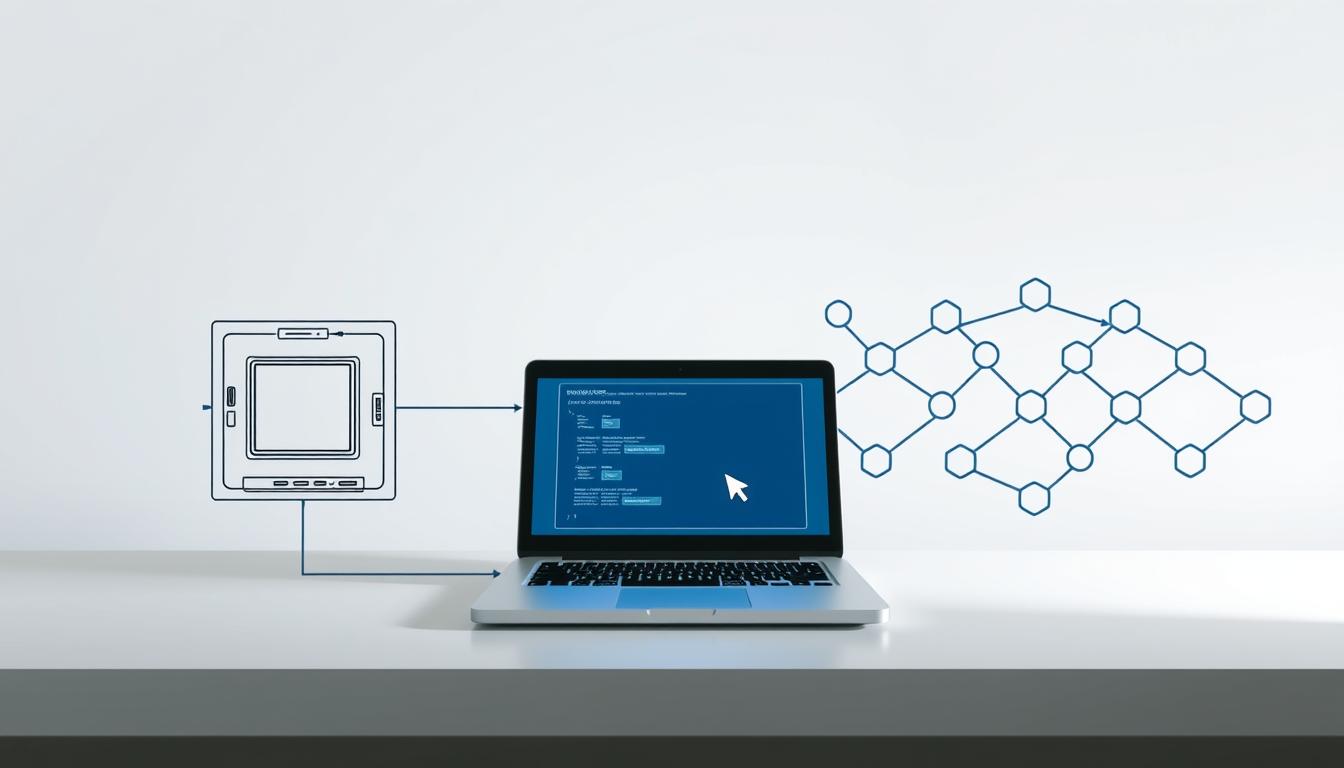
Participant processors form the backbone of decentralized systems, acting as the guardians of transparency and security. These components validate transactions, maintain ledger copies, and enable direct communication across peer-to-peer protocols. Without them, networks couldn’t achieve consensus or resist centralized control.
Every processor in the system stores identical records of transactions, creating redundancy that prevents data manipulation. This design ensures no single entity can alter historical records, making the framework inherently tamper-proof. The open-source nature of these tools allows developers to adapt them for various applications while maintaining network integrity.
This guide simplifies the technical aspects of deploying these critical components. You’ll learn how peer-to-peer protocols enable real-time data sharing between devices and why proper configuration matters for seamless operation. We’ll also explore hardware requirements and security best practices to optimize performance.
Key Takeaways
- Participant processors validate transactions and maintain copies of the ledger across decentralized systems
- Peer-to-peer protocols enable direct communication between network components
- Redundant data storage across devices prevents tampering and ensures transparency
- Proper configuration ensures optimal participation in decentralized networks
- Open-source architecture allows customization while preserving security standards
Understanding the Role of Blockchain Nodes in the Network
In decentralized systems, nodes function as critical validators, maintaining the ledger’s integrity and enabling secure transactions. These components verify every action against predefined rules before adding it to the permanent record. Their distributed nature eliminates reliance on central authorities while boosting system resilience.
- Transaction verification: Cross-checking payment details against historical data
- Data storage: Maintaining updated copies of the entire transaction history
- Consensus participation: Collaborating with other components to validate new entries
Decentralized networks become faster and more cost-effective as more participants join. This expansion reduces bottlenecks by spreading workload across multiple devices. Real-time communication between components ensures all copies stay synchronized without manual intervention.
Running these components offers two key advantages:
- Enhanced security through continuous monitoring of network activity
- Improved transaction speeds via distributed processing power
Properly configured systems automatically share updates across peer-to-peer connections. This design prevents single points of failure while maintaining transparent access to historical records. Understanding these interactions helps users optimize their participation in decentralized ecosystems.
Essential Hardware Requirements for Node Setup
Choosing the right equipment forms the foundation for maintaining decentralized networks effectively. Modern systems need robust components to handle constant data verification and storage demands. Let’s break down what you’ll need to keep operations smooth and secure.

Minimum Hardware Specifications
For Bitcoin networks, start with 750 GB of SSD storage and 8 GB RAM. These components ensure fast read/write speeds (70 MB/s and 32 MB/s respectively) during data synchronization. Ethereum’s full mode demands even more power – 16 GB RAM and 500 GB SSD space handle complex smart contracts efficiently.
- Processor: Multi-core CPUs manage transaction validation
- Internet: 400 KB/s minimum speed for real-time updates
- Power: Uninterrupted supply prevents sync interruptions
Upgrading Your System for Optimal Performance
Exceeding baseline specs future-proofs your operations. Double the RAM to 16 GB reduces processing bottlenecks during peak activity. High-end SSDs with 100 MB/s read speeds slash synchronization times by 40% compared to standard drives.
Bandwidth matters more than many realize. Upgrade to 5 MB/s upload speeds if running multiple services. For those exploring crypto mining operations, dedicated GPUs can share resources with validation tasks during downtime.
- Monitor storage growth – add 25% capacity annually
- Use enterprise-grade cooling systems for 24/7 operation
- Implement backup power solutions for network consistency
Downloading and Installing Node Software
Setting up network components begins with secure software acquisition from trusted sources. Authentic packages protect against malicious code while ensuring compatibility with decentralized protocols. Always use official repositories to download the latest stable versions.
Bitcoin Core Implementation Steps
Start by grabbing Bitcoin Core from its official website. Verify release signatures using PGP tools before extracting files. Linux users execute tar -xzf commands, while Windows installations use familiar .exe files.
Create dedicated storage directories during setup. Choose between GUI mode for visual tracking or daemon operation for background processing. Configuration files let you customize data paths and network ports.
Ethereum Client Selection Guide
Multiple Ethereum clients like Geth and Nethermind cater to different technical needs. Full synchronization preserves entire transaction history but demands 1TB+ storage. Light modes conserve resources by fetching data on demand.
- Hardware alignment: Match client software to your system’s RAM and storage
- Sync speed: Fast mode skips older transactions for quicker startup
- Security checks: Validate checksums before launching any client
Step-by-Step Blockchain Node Setup

Establishing a functional participant in decentralized networks requires precise execution of sequential steps. Begin by confirming your system meets the hardware benchmarks discussed earlier – insufficient resources will derail operations before they start.
Follow this roadmap for seamless integration:
- Environment preparation: Install OS updates and security patches
- Software deployment: Download verified clients using encrypted connections
- Network optimization: Configure firewalls to allow peer communication ports
The synchronization phase tests patience as historical data downloads. This critical process verifies every transaction since the network’s creation. Expect 3-7 days for initial sync completion on major chains.
Key verification checks include:
- Consistent inbound/outbound peer connections
- Real-time validation of new transactions
- Accurate block height progression
Implement monitoring tools during configuration to track system health. Automated alerts for memory leaks or connection drops prevent costly downtime. Regular backups protect against data corruption – schedule them weekly.
Successful participants strengthen the entire network by enhancing security and transaction speed. While technical, each step builds toward creating a self-sustaining component in decentralized ecosystems.
Configuring and Synchronizing the Node with the Blockchain
Bringing a new participant online requires careful alignment with existing network operations. The synchronization phase acts as a digital handshake, verifying historical records while establishing trust within decentralized ecosystems.
Initial Block Download (IBD) serves as the foundation for this process. Your system retrieves every verified action since the network’s creation, building a complete transaction timeline. This data verification ensures compatibility with other participants before active involvement begins.
The Synchronization Process Explained
Bitcoin’s IBD demands approximately 340 GB of storage – equivalent to 60 hours of 4K video. Systems with 50+ Mbps connections typically complete this in 5 days. Slower speeds extend the timeline significantly, emphasizing the need for stable internet.
Three critical stages occur during synchronization:
- Historical retrieval: Downloading blocks from the genesis point
- Cryptographic checks: Validating each transaction’s digital signature
- Chain alignment: Matching local records with network consensus
Interruptions won’t force complete restarts – most software resumes from the last confirmed block. However, frequent disruptions increase verification times by 20-35%. Schedule syncs during off-peak hours for optimal bandwidth allocation.
Ethereum and other networks have different requirements, but all share core synchronization principles. Proper configuration ensures your system contributes to network security while maintaining real-time accuracy across distributed ledgers.
Testing and Verifying Node Functionality

Confirming operational readiness requires systematic checks across multiple layers. Start by querying your component through command-line tools – getblockchaininfo reveals synchronization progress, while getnetworkinfo displays active peer connections. These commands provide instant health reports without third-party tools.
Network communication tests validate data flow between devices. Open TCP ports 8333 (Bitcoin) or 30303 (Ethereum) to enable inbound connections. Use online port scanners to confirm external accessibility. Stable links should show 8-12 active peers within minutes.
Transaction verification proves your system enforces consensus rules. Send small amounts between wallets and monitor validation speed. Properly functioning components will:
- Confirm legitimate transactions in 2-15 seconds
- Reject invalid signatures immediately
- Maintain consistent block height with network
Performance metrics expose hidden issues. Track memory usage during peak activity and watch for sudden drops in peer count. Automated monitoring tools generate alerts for critical events like sync failures or storage bottlenecks.
Final security checks ensure cryptographic integrity. Compare local transaction hashes with public explorers. Mismatches indicate potential data corruption requiring resynchronization. Thorough testing creates trust in your component’s ability to support decentralized ecosystems reliably.
Overcoming Technical and Bandwidth Challenges
Maintaining reliable participation in decentralized networks demands overcoming connectivity and security hurdles. Limited internet infrastructure and evolving cyber threats create unique obstacles for operators. Strategic planning helps balance performance with resource constraints.
Handling Network Limitations
Bandwidth-intensive operations strain standard home internet plans. Users with data caps often face synchronization failures during initial setup. One solution involves scheduling large downloads during off-peak hours when ISPs may offer unlimited data.
Unstable connections disrupt communication between network participants. Operators report 30-50% longer sync times when using Wi-Fi instead of wired ethernet. Monitoring tools help identify patterns in connection drops – crucial for troubleshooting intermittent issues.
- Prioritize UDP protocols for faster data transmission
- Use Quality of Service (QoS) settings to allocate bandwidth
- Maintain multiple peer connections for redundancy
Security and Virus Protection Measures
Security software sometimes flags legitimate network traffic as suspicious. Configure antivirus exceptions for blockchain data directories to prevent accidental quarantine. Regular scans remain essential – malware targeting privacy-focused systems increased 140% last year.
Firewalls require precise rules to enable peer discovery without exposing vulnerabilities. Consider these essential protections:
- Enable intrusion detection systems
- Rotate API keys every 90 days
- Implement two-factor authentication for remote access
New participants should mask their public IP addresses during initial synchronization. This prevents targeted attacks while establishing network trust. Backup power supplies and secondary internet connections maintain uptime during outages.
Comparing Different Node Types and Their Uses
Different roles in decentralized networks require specialized components to maintain efficiency. Each participant type balances resource demands with operational responsibilities, shaping how systems verify and record transactions.
Full Participants vs. Lightweight Options
Full nodes serve as network historians, storing every transaction since the system’s launch. They validate new entries against historical patterns and enforce protocol rules. This comprehensive approach makes them ideal for developers and institutions needing complete oversight.
Lightweight alternatives conserve storage by downloading only essential data. These options suit mobile devices or systems with limited bandwidth. While faster to deploy, they rely on full participants for complete verification.
Other variants fill specific roles:
- Mining units combine validation with block creation
- Staking systems lock cryptocurrency to secure proof-of-stake networks
- Authority validators govern access in private chains
Choosing the right type depends on your hardware capacity and participation goals. Full nodes offer maximum security but demand significant resources. Lightweight versions provide accessibility while maintaining core verification functions.
FAQ
What role do nodes play in maintaining a decentralized network?
Nodes store, validate, and relay transaction data across the system. They enforce consensus rules, verify new blocks, and ensure no single entity controls the entire ledger.
What hardware is needed to run a full node efficiently?
A multi-core processor (4+ cores), 16GB RAM, and 2TB+ SSD storage are recommended. High-speed internet (50+ Mbps) ensures smooth synchronization and peer communication.
How do Bitcoin Core and Geth differ in installation requirements?
Bitcoin Core focuses on UTXO validation and requires ~500GB storage. Geth for Ethereum demands more RAM (16GB+) due to smart contract processing and state growth.
Why does initial synchronization take days to complete?
Nodes download and validate every historical block. Factors like bandwidth, storage speed, and network congestion impact duration—archival modes add extra verification steps.
Can limited bandwidth affect node reliability?
Yes. Low upload speeds hinder data sharing with peers. Prioritize wired connections over Wi-Fi, and configure port forwarding (e.g., port 8333 for Bitcoin) to improve connectivity.
What security practices protect against malicious attacks?
Use firewalls to restrict unauthorized access, enable encryption for data at rest, and regularly update software. Tools like Fail2Ban automatically block suspicious IP addresses.
When should someone choose a light node over a full node?
Light nodes suit mobile wallets or low-resource devices—they rely on trusted servers for block headers. Full nodes offer independent validation but require significant storage.

No comments yet